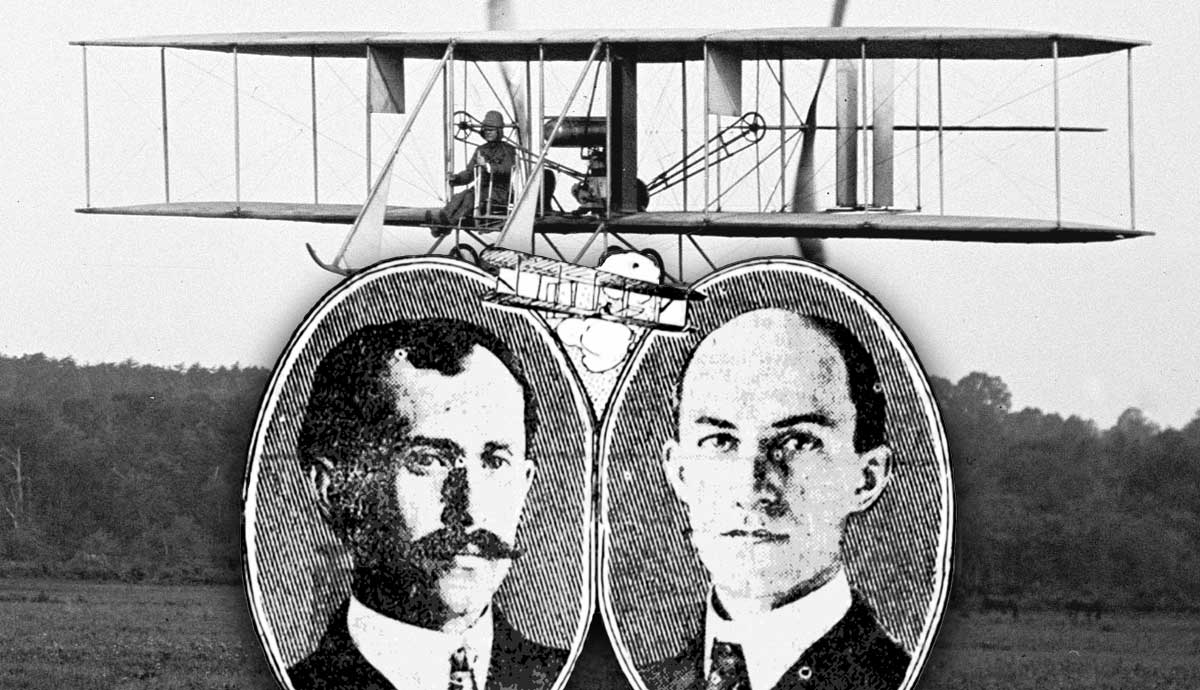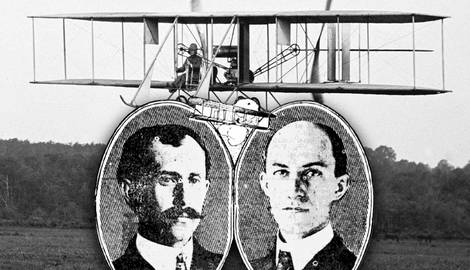
December 17, 1903 was a cold and windy morning on Kitty Hawk Beach off North Carolina’s mainland coast. On that day, years of research and faith in their project would pay off for Wilbur and Orville Wright when their Wright Flyer lifted off from the ground using its own power and flew hundreds of feet through the air.
This was the first step in a revolution that would alter the course of human history.
That day, the Wright brothers etched their names in history and will forever be remembered as the duo that transformed our dreams of flight into reality.
The Wright Brothers’ Childhood

Wilbur and Orville Wright were born into a fairly large family. Their father was Milton Wright, a clergyman, and their mother was Susan Catherine Koerner. Wilbur and Orville were two of seven children.
Wilbur was born on April 16, 1867 in Millville, Indiana, and Orville was born on August 19, 1871 in Dayton, Ohio. The family had moved around a lot before finally settling in Dayton in 1884.
The spark of interest for flight came in 1878 when Milton brought home a toy helicopter for his children to play with. The one-foot-long contraption was made of bamboo and cork with a rubber band to drive its rotor. Wilbur and Orville were fascinated by this toy and played with it until it broke. Such was its impact that the brothers built their own.
Wilbur and Orville had challenges in their childhoods and early adult years. The family’s movement on account of Milton’s work caused the children to integrate into several different schools. As a result, neither Wilbur nor Orville received their high school diplomas; however, they grew up in a home where intellectual interests were encouraged, and the Wright brothers’ curiosities were fed in a healthy environment.

Wilbur had been an athletic child, and when he was 18, he was struck in the face by a hockey stick and lost his front teeth. The experience was traumatic, and Wilbur became withdrawn. He was attentive to his mother, who was dying of tuberculosis. He also helped his father, but Milton noted a lack of ambition in Wilbur, which was a concern. Susan would eventually succumb to the disease in 1889.
In 1888, Orville dropped out of high school and started a printing business. The printing press that he used was designed by himself and his brother. Wilbur also joined Orville in the printing shop, and together, they printed newspapers over the next few years, most notably West Side News, a weekly periodical.
Their next endeavor revolved around the new bicycling craze sweeping the nation. They opened a bicycle repair shop, and a few years later, they started manufacturing and selling their own brand. Their experience in this field would contribute significantly to their experiments with flight as they both honed their skills by building things out of wood, wire, and metal tubing, which were perfect materials for the construction of early airplanes.
The Road to Flight

The Wright brothers began reading voraciously on aeronautical treatises at the time and put their minds to work on how to overcome the limitations of gravity. They were natural engineers and relied heavily on the theory of using fixed wings to achieve their goals. Their methods were so successful that many of their design principles are still in use today.
Through their research, the Wright brothers concerned themselves mainly with three elements. They needed structurally sound wings to serve as the lifting surfaces. They also needed a method of propulsion, as well as a means of controlling their aircraft.

The wings they designed met the needs of controlling the direction of the vehicle through sets of pulleys that “warped” the wings to respond to oncoming airflow. Through this design feature, they would be able to pilot the aircraft through roll.
Their first construction to test this theory was with a kite. In 1899, Wilbur took the kite they had built out into a field and tested the “wing warping” design, much to the amazement of a group of schoolboys who were the only witnesses to this step towards a historic moment. The design worked perfectly, and the brothers set upon the next task of building a glider.

This task was considerably dangerous and had to be precise. The glider was intended to carry a man, and any mishap could result in injury or death. Wing shape and size had to be considered, and a method had to be devised to control the vehicle’s ascent and descent (or pitch). They drew extensively from other pioneers in the field, most notably Otto Lilienthal, who had calculated a table of coefficients of lift and drag. The data in this research was vital for creating the design of the Wright Glider and, later, the Wright Flyer.
In August, the Wright brothers began construction on their glider. A few weeks later, it was finished and ready for testing. The glider worked spectacularly, achieving a full two minutes of flight on one attempt. The controls worked well, and the Wright brothers were ready to move on to their magnum opus – The Wright Flyer.
The Wright Flyer

Having tested all their theories posited for the achievement of flight, the Wright brothers set upon the task of building the Wright Flyer. With the help of Charles Taylor, who worked at their bicycle shop, they built a 4-cylinder engine to provide power to their craft. Twin propellers were also added.
They spent seven weeks constructing the Wright Flyer, and on December 14, the aircraft was ready for testing. The brothers flipped a coin to see who would pilot the craft, and Wilbur won. The first attempt at flight, however, was a failure. Wilbur stalled the craft upon takeoff and pitched the front of it into the ground, causing minor damage. The day’s efforts were halted, and the brothers retired to fix the Wright Flyer.

Three days later, on December 17, the second attempt was made. Kitty Hawk Beach, off the coast of North Carolina, was where history would be made. It was 10:35 in the morning, and it was a fairly windy Thursday.
Orville was the first to take flight with the Wright Flyer. The flight lasted 12 seconds and covered 120 feet. It was anything but smooth. The aircraft bobbed about, and Orville struggled to keep the Flyer under control. He would describe the flight as “extremely erratic.” Wilbur piloted the craft next and achieved 175 feet in the same amount of time. The third attempt saw Orville fly 200 feet in 15 seconds, and the fourth and final attempt saw Wilbur fly 852 feet in 59 seconds.
The Wright Stuff

Wilbur and Orville did not stop once they had achieved flight. They continued to work on their designs, improving the Wright Flyer so that it was easier to control and could achieve longer periods of flight. Within two years of their first flight, they were able to keep the airplane in the sky for 39 minutes and were also able to achieve complex maneuvers.
The Wright brothers took their invention into the commercial sphere and, after patenting it, released their creation to the public. They were granted contracts with the US Army and with French investors who were interested in building the Wright airplanes under license.
Flying, of course, was tricky and dangerous, and their business ventures were not without mishaps. While training the first US Army pilots, a split propeller caused a crash that injured Orville and killed his passenger. Nevertheless, the Wright Brothers were able to meet the US Army’s specifications, and they began selling their flyers to the military.

In 1909, the Wright Company was established and attracted several high-profile investors, giving the Wright brothers fame and success. However, the business also attracted negative elements, and the Wright brothers had to contend with several lawsuits against rival companies. By protecting their interests from those infringing on their copyrights, the Wright brothers began to be seen as standing in the way of progress. Their reputations took a knock.
The Wright brothers were active in protecting their patents from what they perceived as copyright infringement. In total, they brought 12 lawsuits against their competitors. One of the most notable lawsuits was when the Wright brothers filed against Glenn Curtiss for using ailerons (a hinged surface in an airplane wing that controls lateral balance), an invention that was patented by the Wright brothers.
Their patents, however, expired in 1917, and other inventors sprung upon the opportunity to invent and market aircraft of their own. Nevertheless, the Wright brothers continued to be honored for their groundbreaking work in the field of flight.
The Death of Wilbur & Continuing the Wright Legacy

Wilbur Wright died of typhoid fever in 1912 at the age of 45, and Orville took over the running of the company until 1915, when he sold it to a group of financiers. Throughout the following years, Orville was very active in the aeronautics industry but had a long-running feud with the Smithsonian Institution, which claimed their third president, Samuel Langley, had invented an aircraft capable of flight before the Wright brothers. His claim wasn’t retracted until 1942.
Orville’s life, however, was one of much leisure following the success of the Wright business. He spent much time with his family and tinkering in his workshop.
Orville eventually died from a heart attack on January 30, 1948 at the age of 76, and was buried in Woodland Cemetery in Dayton.
When he died in 1948, Orville had seen the transformation of flight from the Wright Flyer to the biplanes of the First World War to the incredible planes of the Second World War, including the first jet fighter. Air power had become vital to military endeavors, and airplanes had transformed human civilization. All of it came from that first blustery day in 1903 when the Wright Flyer struggled off the ground of Kitty Hawk Beach and etched the Wright brothers into the history books forever.










